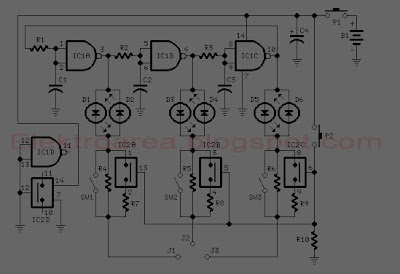
Testing procedure:
- Connect randomly the pins of the transistor under test to J1, J2 and J3 sockets or clips.
- Close SW1, SW2 and SW3.
- Push on P1; if the transistor is in good health the response of the Identifier will be:
- Two terminals will show both LEDs illuminated, the remaining one will show a single LED illuminated.
- If the LED illuminated is Red, the pin connected to the related connector will be the Base of a NPN transistor.
- If the LED illuminated is Green, the pin connected to the related connector will be the Base of a PNP transistor.
- Open the switch related to the single illuminated LED: the two terminals showing both LEDs illuminated will change their state and a single LED per terminal will be illuminated. The LED which previously indicated the Base pin will turn-off.
- If the transistor was previously identified as NPN, the pin connected to the now illuminated Green LED will be the Emitter, whereas the pin connected to the Red LED will be the Collector.
- If the transistor was previously identified as PNP, the pin connected to the now illuminated Red LED will be the Emitter, whereas the pin connected to the Green LED will be the Collector.
his procedure will suffice for reliable pin identification of most transistor types. In some cases, mainly when low-gain high power transistors are tested, the LED could illuminate faintly and reliable pin identification could be not so easy. Pushing both P1 and P2 will remedy this shortcoming.
Important
Unfortunately, testing Darlington type transistors could lead to some trouble. In fact, the Base pin and the polarity of these transistor types will be correctly shown by the Pin Identifier in the same way as common transistors, but Collector and Emitter pins will be displayed inverted; i.e. if the transistor was previously identified as NPN, the pin connected to the now illuminated Green LED will be the Collector (NOT the Emitter), whereas the pin connected to the Red LED will be the Emitter (NOT the Collector). On the other hand, if the transistor was previously identified as PNP, the pin connected to the now illuminated Red LED will be the Collector (NOT the Emitter), whereas the pin connected to the Green LED will be the Emitter (NOT the Collector).
This is due to the fact that Darlington power transistors usually incorporate on the same chip a reverse-connected diode across Emitter and Collector. Doubts can be easily dissipated pushing on P2: Darlington transistors will cause all two LED pairs related to Emitter and Collector pins to illuminate brightly. On the contrary, common transistors will cause only a faint illumination of the remaining LEDs and, usually, a single LED indicating the Collector pin will illuminate.
This is due to the fact that Darlington power transistors usually incorporate on the same chip a reverse-connected diode across Emitter and Collector. Doubts can be easily dissipated pushing on P2: Darlington transistors will cause all two LED pairs related to Emitter and Collector pins to illuminate brightly. On the contrary, common transistors will cause only a faint illumination of the remaining LEDs and, usually, a single LED indicating the Collector pin will illuminate.
No comments:
Post a Comment